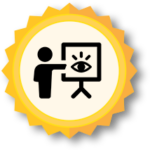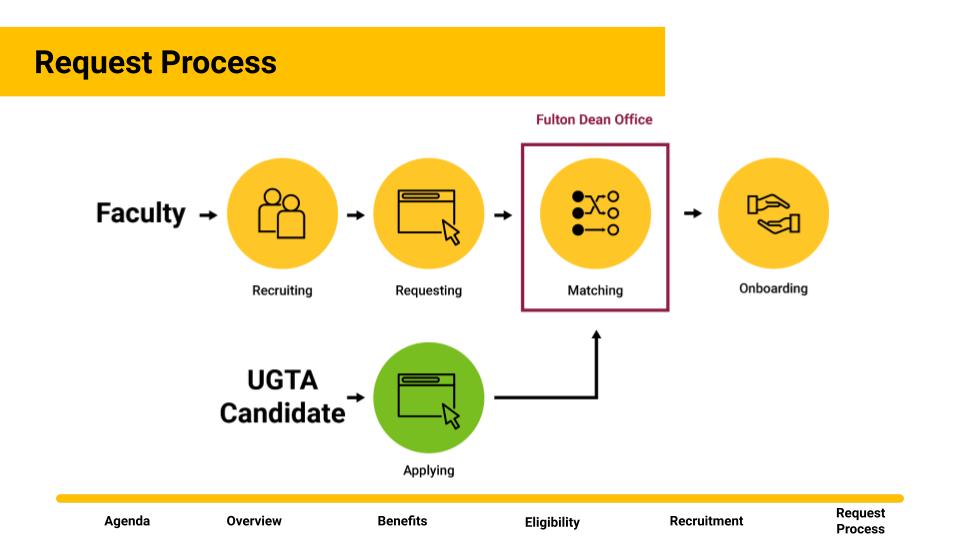Undergraduate Teaching Assistants
 Overview and Introduction: The WHAT and WHO
Overview and Introduction: The WHAT and WHO
Undergraduate Teaching Assistants (UGTAs) are successful engineering students who serve as a resource to students and faculty by assisting with the facilitation of active learning techniques. UGTAs can spend approximately five hours per week in the classroom serving as teaching assistants.
UGTAs are a critical part of the “Fulton Difference” experience so students have a variety of resources to enhance their success in the classroom. UGTAs help students navigate the institution, promote self-confidence and self-reliance, act as role models who demonstrate personal and academic success, and offer academic support and guidance to their peers in the classroom.
Faculty members need to request UGTAs for their courses at the UGTA Faculty Portal. There is a series of accompanying training videos on their website that include:
- UGTA program overview
- Student eligibility explanation
- UGTA recruitment and request process
- Examples of UGTA responsibilities
- Faculty responsibilities summary
Please note that it is highly recommended to recruit UGTAs for your classes. Also, students interested to serve as an UGTA need to submit an application via the UGTA Student Portal.
Who are the UGTAs?
UGTAs are successful undergraduate engineering students who are in good academic standing, hold no pending Academic Integrity Policy violations, and have completed their assigned course with a grade of “B” or higher. UGTAs work in a mentor-mentee relationship with faculty, supporting faculty to facilitate active learning techniques, creating a learning community and a sense of belonging, and responding to general student inquiries. They do not grade, provide instruction, nor solely support technical issues.
Is a UGTA right for you?
UGTAs can be requested for in-person, hybrid, and online courses in FSE. Commonly, UGTAs are utilized to support student success and engagement within introductory courses with larger enrollment. However, UGTAs have proven valuable at all levels of undergraduate programs.
Faculty can request one UGTA per 40 students enrolled, exceptions can be made if approved by the ASA department. The UGTA will be assigned for the entire session, and is required to generally work 5 hours per week. The student should not be working as a UGTA until they have received an official offer letter from the Academic & Student Affairs UGTA office.

 Implementation and Timing: The WHEN, WHERE, and HOW
Implementation and Timing: The WHEN, WHERE, and HOW
Requesting a UGTA
Deadlines are announced at the end of every semester for the subsequent semester’s UGTA requests. In general, a notification will be sent by the Vice-Dean of Academic and Student Affairs.

To successfully request and place UGTAs in your class, please:
- Recruit students for potential UGTA candidates.
- Request UGTAs via the UGTA Faculty Portal
- Ensure UGTA Candidates submit an application to the UGTA Student Portal
- Onboard UGTAs for your class.
Your UGTA is approved – now what?
As this is meant to be a mentorship program, faculty should meet with their assigned UGTA to review expected responsibilities in the course, plan activities and number of hours dedicated to those activities every week, discuss potential self-selected assignments and how that may value a course, and schedule the UGTA-Faculty Year-End Evaluation. This planning is an important step for faculty to complete with their UGTA to ensure a successful semester and experience.
Active learning instructional strategies are an excellent use of UGTAs – please see our Active Learning: Overview and Introduction Quick-Reference Guide for more information on this approach. A few ideas below:
| UGTAs can assist with | UGTAs cannot |
|
|
The UGTA program is truly meant as a mentorship program between you and your assigned UGTA. This opportunity is a chance for high achieving students to learn about academia as a profession and build relationships with engineering faculty members.

 Rationale and Research: The WHY
Rationale and Research: The WHY
There are many benefits of the UGTA program for the students participating, as well as the faculty who lead them. Those benefits include:
- Improve student learning outcomes
- Leverage UGTA to implement active learning strategies for classes or labs that are otherwise difficult with one instructor.
- Create online communities for online and/or in-person courses where students can interact with UGTAs.
- Develop, improve, and build UGTA communication and leadership skills
- Foster working relationships with students
- Help UGTA earn valuable resume and classroom facilitation experience

 Additional Resources and References
Additional Resources and References
- UGTA Faculty Resource Page: https://faculty.engineering.asu.edu/teaching/undergraduate-teaching-assistants/
- FSE Undergraduate Teaching Assistants: https://engineering.asu.edu/ugta/
- UGTA Faculty Request Portal: https://fultonapps.asu.edu/ugta/
- UGTA Student Application Portal: https://fultonapps.asu.edu/ugta/apply/
- Summary of Classroom Ideas